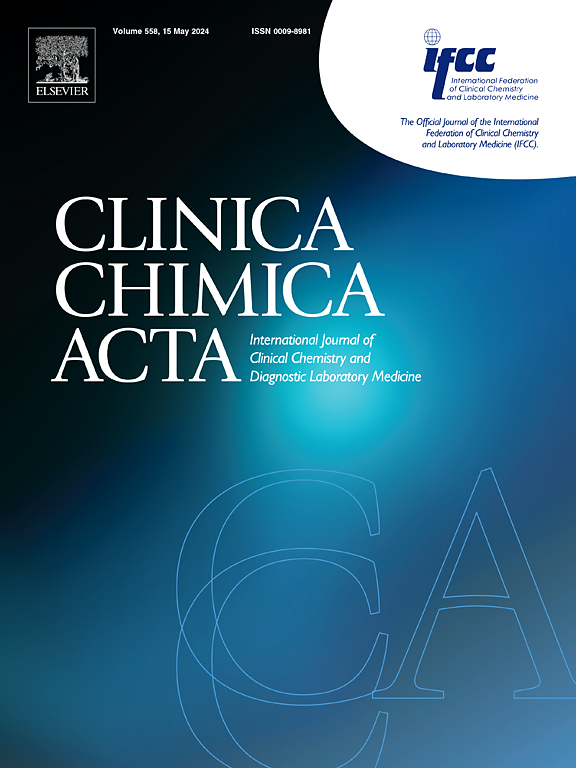糖化白蛋白不适用于鉴别中国孕妇妊娠期糖尿病
IF 2.9
3区 医学
Q2 MEDICAL LABORATORY TECHNOLOGY
引用次数: 0
摘要
一些研究表明,糖化白蛋白(GA)可能是孕妇诊断和监测妊娠糖尿病(GDM)的有用生物标志物。然而,在一般孕妇人群中,GA是否是筛查GDM的足够准确的标记物尚不清楚。本研究旨在探讨GA在中国孕妇GDM筛查中的作用。方法本研究纳入298例妊娠24 ~ 28周的中国妇女。根据血糖水平检测,确定糖耐量正常的女性247例,GDM患者51例。采用三种不同的试剂盒测定GA浓度(GA%),均采用酮胺氧化酶法进行分析。结果首先,我们发现GDM组GA%水平显著高于健康对照组。其中,健康人Lucica、Maccura、Gcell组GA%分别为12.86±0.8458、13.40±0.9344、10.98±1.009,GDM组GA%分别为13.21±1.101、13.78±1.219、11.44±1.449。ROC曲线分析显示,各试剂盒的曲线下面积(AUC)均小于0.7 (Lucica, AUC = 0.6149;macura, AUC = 0.6140;Gcell, AUC = 0.6078),不支持将GA作为GDM的筛选工具。结论a不是早期筛查GDM的良好指标。本文章由计算机程序翻译,如有差异,请以英文原文为准。
Glycated albumin is not applicable to differentiate gestational diabetes mellitus in Chinese pregnant women
Purpose
Some studies have suggested that Glycated albumin (GA) may represent a useful biomarker in pregnant women for diagnosing and monitoring gestational diabetes mellitus (GDM). However, whether GA is a sufficiently accurate marker to screen GDM in a general population of pregnant women remains unclear. The current study aimed to investigate the role of GA in screening GDM in Chinese pregnant women.
Methods
In this study, 298 Chinese women between 24–28 weeks of gestation were included. A total number of 247 women with normal glucose tolerance and 51 with GDM were identified according to the glucose levels detection. GA concentrations (GA%) were measured using three different kits, all of which utilized the ketoamine oxidase method for analysis.
Results
Firstly, we found the GA% levels of the GDM group were significantly higher than those of healthy control. Specifically, the GA% level of the healthy control using Lucica, Maccura, Gcell was respectively 12.86 ± 0.8458, 13.40 ± 0.9344 or 10.98 ± 1.009, while that of the GDM patients was respectively 13.21 ± 1.101, 13.78 ± 1.219 and 11.44 ± 1.449. Then, the Receiving operator characteristic (ROC) curve analysis revealed that the areas under the curve (AUC) of all kits were less than 0.7 (Lucica, AUC = 0.6149; Maccura, AUC = 0.6140; Gcell, AUC = 0.6078), which do not provide support for the utilization of GA as a screening tool for GDM.
Conclusion
GA is not a good indicator for screening GDM initially.
求助全文
通过发布文献求助,成功后即可免费获取论文全文。
去求助
来源期刊

Clinica Chimica Acta
医学-医学实验技术
CiteScore
10.10
自引率
2.00%
发文量
1268
审稿时长
23 days
期刊介绍:
The Official Journal of the International Federation of Clinical Chemistry and Laboratory Medicine (IFCC)
Clinica Chimica Acta is a high-quality journal which publishes original Research Communications in the field of clinical chemistry and laboratory medicine, defined as the diagnostic application of chemistry, biochemistry, immunochemistry, biochemical aspects of hematology, toxicology, and molecular biology to the study of human disease in body fluids and cells.
The objective of the journal is to publish novel information leading to a better understanding of biological mechanisms of human diseases, their prevention, diagnosis, and patient management. Reports of an applied clinical character are also welcome. Papers concerned with normal metabolic processes or with constituents of normal cells or body fluids, such as reports of experimental or clinical studies in animals, are only considered when they are clearly and directly relevant to human disease. Evaluation of commercial products have a low priority for publication, unless they are novel or represent a technological breakthrough. Studies dealing with effects of drugs and natural products and studies dealing with the redox status in various diseases are not within the journal''s scope. Development and evaluation of novel analytical methodologies where applicable to diagnostic clinical chemistry and laboratory medicine, including point-of-care testing, and topics on laboratory management and informatics will also be considered. Studies focused on emerging diagnostic technologies and (big) data analysis procedures including digitalization, mobile Health, and artificial Intelligence applied to Laboratory Medicine are also of interest.
 求助内容:
求助内容: 应助结果提醒方式:
应助结果提醒方式:


